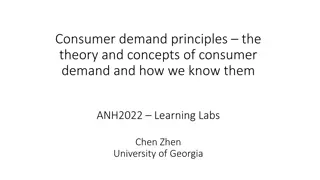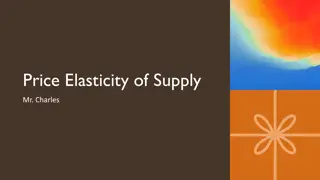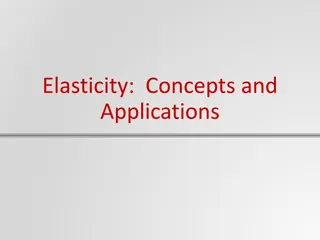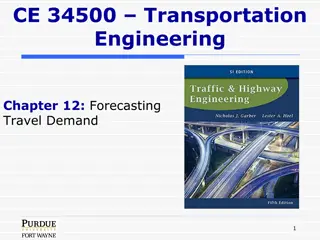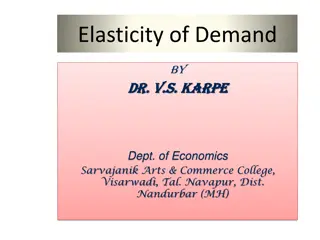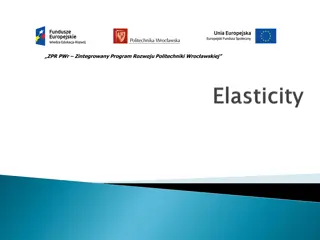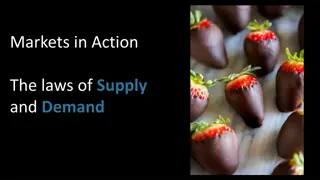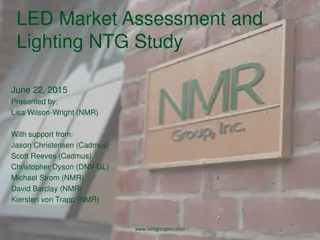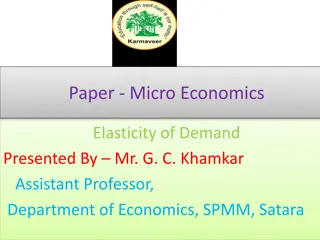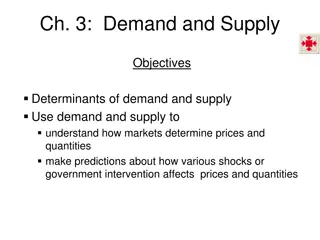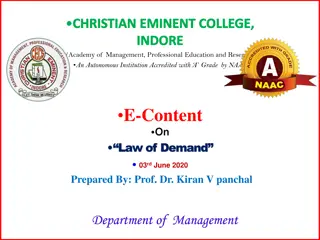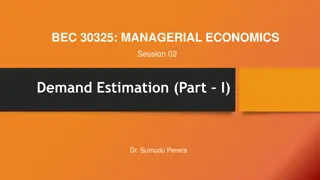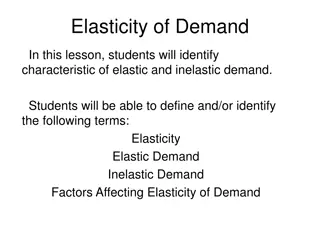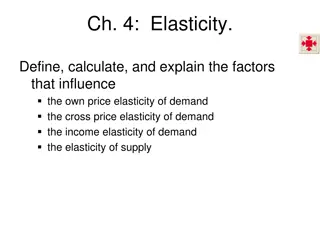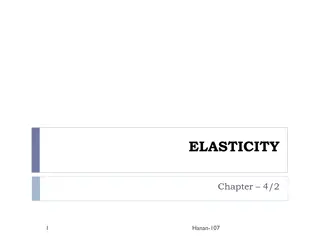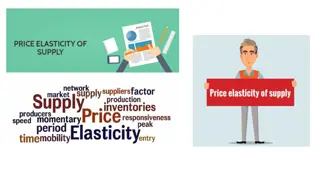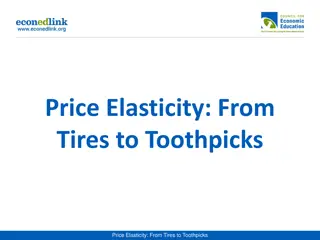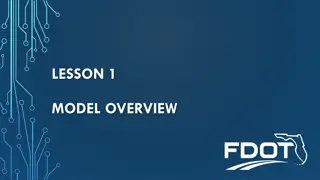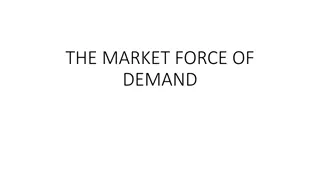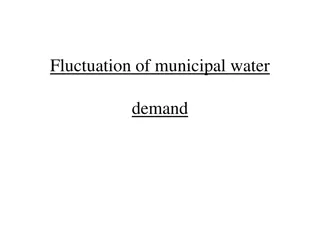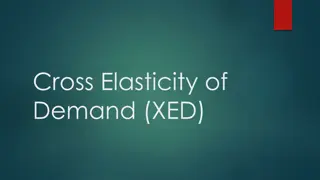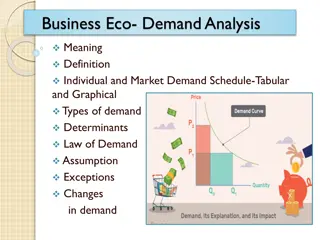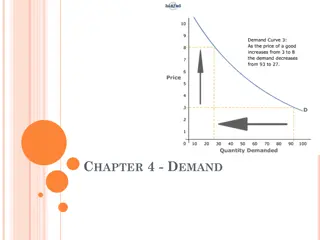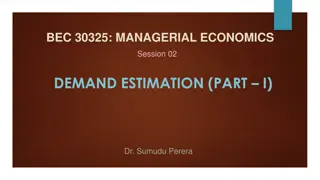Demand Estimation and Demand Forecasting
Demand estimation and forecasting are crucial processes for businesses to predict future demand for their products or services. Demand estimation involves analyzing the impact of various variables on demand levels and pricing strategies, while demand forecasting helps in planning production, new pro
2 views • 7 slides
Principles of Traffic Demand Analysis and Highway Demand Forecasting
Understanding traffic flows is crucial in designing highways and managing traffic effectively. Traffic demand analysis involves forecasting future traffic volumes, modeling demand, and determining the necessary infrastructure improvements. This analysis helps in estimating axle loadings, pavement th
2 views • 36 slides
Overview of Army Modeling and Simulation Office
The U.S. Army Modeling and Simulation Office (AMSO) serves as the lead activity in developing strategy and policy for the Army Modeling and Simulation Enterprise. It focuses on effective governance, resource management, coordination across various community areas, and training the Army Analysis, Mod
2 views • 8 slides
Understanding Consumer Demand Principles and Elasticity Theories
Explore the theory of consumer demand, including the principles of price-demand relationship, homogeneity, symmetry, and price elasticity. Delve into the concepts of own-price elasticity, cross-price elasticity, and expenditure elasticity to understand how changes in prices and income affect consume
1 views • 8 slides
Understanding Demand in Economics: Chapter 4 Overview
Demand in economics is dictated by the law of demand, where lower prices lead to increased purchases and vice versa. This chapter delves into the factors influencing demand, such as substitution effects, income effects, demand schedules, and market demand. Learn how shifts in the demand curve impact
1 views • 26 slides
Evolution of Modeling Methodologies in Telecommunication Standards
Workshop on joint efforts between IEEE 802 and ITU-T Study Group 15 focused on information modeling, data modeling, and system control in the realm of transport systems and equipment. The mandate covers technology architecture, function management, and modeling methodologies like UML to YANG generat
1 views • 16 slides
Understanding Geometric Modeling in CAD
Geometric modeling in computer-aided design (CAD) is crucially done in three key ways: wireframe modeling, surface modeling, and solid modeling. Wireframe modeling represents objects by their edges, whereas surface modeling uses surfaces, vertices, and edges to construct components like a box. Each
1 views • 37 slides
Understanding Price Elasticity of Supply: Degrees and Concepts
Explore the concept of Price Elasticity of Supply (PES) through definitions, descriptions of elasticity degrees, and examples like perfectly inelastic, fairly elastic, and unitary elastic. Engage in an activity to deepen your understanding.
1 views • 5 slides
Understanding Price Elasticity in Economics
Explore the key concepts of price elasticity in economics, including calculations, determinants, and applications. Understand the differences between price elasticity of demand and supply, learn how to calculate price elasticity, and interpret elasticity coefficients. Discover the responsiveness of
2 views • 31 slides
Travel Demand Modeling in Transportation Engineering
Travel demand modeling (TDM) is crucial for estimating future travel demand based on assumptions like traffic volume. It helps evaluate roadway improvements, bus services, manage congestion, and estimate pollution emissions. Factors influencing travel demand include land use, population characterist
5 views • 19 slides
Understanding Revenue Concepts in Different Market Conditions
Explore revenue concepts like Total Revenue (TR), Marginal Revenue (MR), and Average Revenue (AR) along with elasticity of demand in various market structures such as perfect competition, monopoly, monopolistic competition, and oligopoly. Learn about short and long-run equilibrium conditions and the
1 views • 21 slides
Introduction to Dynamic Structural Equation Modeling for Intensive Longitudinal Data
Dynamic Structural Equation Modeling (DSEM) is a powerful analytical tool used to analyze intensive longitudinal data, combining multilevel modeling, time series modeling, structural equation modeling, and time-varying effects modeling. By modeling correlations and changes over time at both individu
1 views • 22 slides
Understanding Elasticity of Demand in Economics
Elasticity of demand refers to the responsiveness of quantity demanded to changes in factors like price, related commodities, and consumer income. This concept helps analyze how demand fluctuates with price changes, with examples and calculations provided. Interpretations of numerical values and the
2 views • 25 slides
Insights on Price Elasticity of Demand and Consumer Behavior
Understanding the concept of price elasticity of demand, this content explores how changes in price affect consumers' buying behavior. It covers the Veblen effect, Giffen goods, Marshall's example on staple foods, and the responsiveness of demand to price fluctuations. The content also explains elas
5 views • 31 slides
Understanding Object Modeling in Software Development
Object modeling is a crucial concept in software development, capturing the static structure of a system by depicting objects, their relationships, attributes, and operations. This modeling method aids in demonstrating systems to stakeholders and promotes a deeper understanding of real-world entitie
1 views • 65 slides
Understanding the Law of Demand in Markets
Markets in action demonstrate the laws of supply and demand, where buyers and sellers interact to determine economic output and price. The law of demand states that as prices rise, the quantity demanded decreases, leading to contraction, and vice versa. Through an example of chocolate-covered strawb
0 views • 25 slides
LED Market Assessment and Lighting NTG Study Findings
This document presents the findings from an LED market assessment and lighting NTG study conducted in June 2015. The study includes evaluation tasks such as demand elasticity modeling, supplier interviews, data analysis, and overall reporting. Task leaders were assigned for each specific task to ens
0 views • 27 slides
Understanding Elasticity of Demand in Microeconomics
Elasticity of demand in microeconomics explores the qualitative and quantitative relationships between demand and price. It examines how changes in various factors affect consumer behavior and demand for goods and services. Factors such as price, consumer income, prices of related commodities, numbe
1 views • 8 slides
Subarea and Highway Corridor Studies: Travel Demand Modeling and Refinements
In this lesson, we delve into subarea and corridor studies focusing on travel demand model refinements, highway network coding, corridor congestion relief, and trip assignment theory. Subarea modeling plays a crucial role in forecasting travel within smaller regions with detailed traffic patterns, t
1 views • 45 slides
Understanding Demand and Supply in Market Economics
Explore the fundamentals of demand and supply in market economics, analyzing how prices and quantities are determined. Learn about the factors influencing demand and supply, and how various external factors impact market dynamics. Discover the principles behind the law of demand, demand curves, shif
0 views • 20 slides
Understanding the Law of Demand in Economics
The Law of Demand explains the inverse relationship between the price of a product and the quantity demanded. As the price increases, demand decreases, and vice versa. Factors affecting demand include the price of substitute and complementary goods, consumer income, preferences, and time. The Demand
1 views • 17 slides
Managerial Economics: Understanding Demand Estimation
Explore the fundamental concepts of demand estimation in managerial economics, covering topics such as the definition of demand, the law of demand, price elasticity, income elasticity, cross elasticity, and more. Dr. Sumudu Perera provides insights on how quantity demanded relates to factors like pr
0 views • 23 slides
Understanding Elasticity of Demand and Factors Affecting It
Identify the characteristics of elastic and inelastic demand, define terms like Elasticity, Elastic Demand, and Inelastic Demand. Explore why we still buy gas despite rising prices, the concept of elastic and inelastic demand using examples like pants and apple juice. Learn about factors influencing
0 views • 16 slides
Understanding Price Elasticity of Demand in Economics
Price elasticity of demand is a crucial concept in economics that measures how much the quantity demanded of a good changes in response to a change in its price. Factors influencing own-price elasticity, cross-price elasticity, income elasticity, and supply elasticity are explained and illustrated u
0 views • 19 slides
Understanding Price Elasticity of Demand in Economics
Price elasticity of demand is a crucial concept in economics, as it measures the responsiveness of quantity demanded to price changes. A higher elasticity value indicates a more significant impact of price changes on demand. The concept helps businesses understand how changes in pricing affect their
0 views • 8 slides
Understanding Elasticity in Economics
Elasticity in economics refers to the responsiveness of demand to price changes. A more elastic curve results in larger quantity changes for small price changes, while a less elastic curve requires larger price changes to affect quantity consumed. The elasticity of demand can be measured by calculat
2 views • 13 slides
Understanding Price Elasticity of Supply in Economics
Price elasticity of supply measures how much the quantity supplied responds to changes in price. It can be inelastic (quantity supplied responds slightly), elastic (quantity supplied responds substantially), or unit-elastic (price elasticity of supply equals 1). Various determinants like the passage
0 views • 16 slides
Understanding Degrees of Elasticity of Demand
Elasticity of demand refers to the responsiveness of quantity demanded to changes in price. Perfectly elastic demand occurs when there is an infinite demand at a particular price and demand becomes zero with a slight rise in price. Conversely, perfectly inelastic demand occurs when there is no chang
0 views • 11 slides
Understanding Price Elasticity in Consumer Behavior
Explore the concept of price elasticity and its impact on consumer behavior through examples ranging from Nikes to Starbucks lattes. Learn how consumers respond to price changes and the importance of elasticity in determining market dynamics. Delve into the interactive activity provided to deepen yo
1 views • 8 slides
Understanding Supply and Demand in Competitive Markets
Supply and Demand are crucial forces in market economies that determine prices and quantities of goods. This content explores the concept of competitive markets, the relationship between demand and price, and the impact of related goods on demand. It delves into market dynamics through examples such
0 views • 50 slides
Enhancing Stream Processing Systems with On-Demand Scalability
This study explores the importance of elasticity and on-demand scaling in stream processing systems, focusing on the development of the Stela system. It introduces novel metrics like Effective Throughput Percentage (ETP) and describes the implementation of on-demand elasticity within Storm without t
0 views • 26 slides
Understanding Travel Demand Models in Transportation Planning
Travel Demand Models play a crucial role in transportation planning by mathematically describing relationships among transportation systems and socioeconomic factors. This lesson provides an overview of travel demand modeling, including basic elements of a model, modeling steps, and advanced topics
0 views • 28 slides
Understanding Demand and Consumer Behavior in Economics
Demand in economics refers to the quantity of a commodity consumers are willing to buy at a given price within a specific time period. Various factors influence demand, such as price, consumer income, related goods prices, consumer preferences, advertising, and population size. Types of demand inclu
0 views • 20 slides
Understanding the Market Force of Demand
Demand is essential in economics, representing the quantity buyers are willing to purchase at different prices. The Law of Demand asserts that as prices rise, demand falls. Through demand schedules and curves, we analyze how factors like price, number of buyers, income, and related goods influence d
3 views • 13 slides
Understanding Municipal Water Demand Fluctuations
There is a wide variation in seasonal, daily, and hourly water demands for municipal water supply. Factors like working days, weather conditions, and time of day influence the demand patterns. Analysis of average demand, maximum day demand, and peak hourly demand is crucial for capacity planning of
1 views • 6 slides
Understanding Cross Elasticity of Demand in Economics
Cross Elasticity of Demand (XED) measures how the demand for one good changes in response to a change in the price of another related good. The concept is explained through examples such as close substitutes, weak substitutes, perfect substitutes, and complementary products. It helps in understandin
0 views • 8 slides
Understanding Demand Analysis in Economics
Demand analysis in economics involves studying individual and market demand, demand schedules, determinants, the law of demand, exceptions, and factors influencing changes in demand. Dr. Sachin M. Prayag explains the concept of demand, including desire, willingness to pay, and ability to pay, with g
1 views • 15 slides
Understanding Demand in Chapter 4
In Chapter 4, the concept of demand is explored, encompassing the desire, ability, and willingness to purchase a product. It delves into the demand schedule, demand curve, law of demand, and factors influencing demand such as consumer income. The chapter also covers marginal utility and the diminish
0 views • 18 slides
Understanding Price Elasticity of Demand in Economics
Explore the concept of price elasticity of demand in economics through a discussion on how changes in pricing can impact revenue generation. Learn about different types of demand elasticity and how to calculate price elasticity of demand using the percentage change in quantity demanded and price. Di
0 views • 51 slides
Managerial Economics - Understanding Demand Estimation Fundamentals
Delve into the world of managerial economics with a focus on demand estimation. Explore concepts such as the law of demand, price elasticity, market demand vs. individual demand, and the demand curve. Learn how to analyze consumer behavior and predict market trends through quantitative analysis tech
0 views • 20 slides



